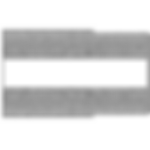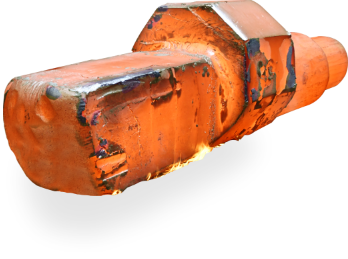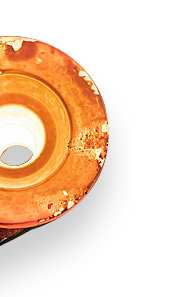
Forging Cost Reductions
.jpg)
Improve Your Parts
Forging can often create economic advantages over other metalworking methods that save time and materials, as well as improve production efficiencies. Scot Forge employee-owners collaborate with you to discover the most viable solutions for your project. Our highly trained account managers, forge engineers, process engineers and metallurgists add decades of knowledge and experience to your team.
CLICK THE TOPICS BELOW AND DISCOVER:
Forging can measurably reduce material costs since it requires less starting stock to produce many part shapes and can achieve near-net shapes, saving on scrap costs.
By minimizing the number of components in a fabricated part and enhancing design, Scot Forge can produce parts with increased quality while reducing overall cost and production time.
PRODUCTION EFFICIENCIES
Scot Forge has many different sizes of starting ingots and billets on hand, providing a wide variety of ready-to-forge inventoried grades. Using the forging process, the same part can be produced from many different sizes of starting ingots or billets, allowing for a wider variety of inventoried grades. This flexibility means that forged parts of virtually any grade can be manufactured more quickly and economically.
Forging also can yield advantages in machining, lead time and tool life. Savings come from forging to a closer-to-finish, or near-net, size than what is capable by alternative metal sources such as torch cutting plate or boring bar. Therefore, less machining is needed to finish the part, with the added benefits of shorter lead times and reduced wear and tear on your equipment.
REDUCED REJECTION RATES
Often discovering a defect in a cast part doesn’t happen until a part has been on a machine for hours, which can be a headache. But, when this happens to multiple parts it can be a nightmare. It takes time and money to replace parts, puts hours on the machine and increases labor costs, not to mention the lost opportunity cost. Because forging has a 3:1 minimum reduction, porosity and piping are eliminated yielding improved structural integrity. Coupled with a weld-free design, forging can dramatically reduce part rejection.

MATERIAL OPTIMIZATION
For example, torch cutting a ring from plate (A), all corner stock and the full center slug are lost, as a result you pay for the excess material. With a forging (B), the part is shaped to a near-net size with minimal waste and optimized use of starting stock.
Open die forging and torch cutting allows for a surprisingly large range of sizes and shapes
Torch cutting to near net shape saves on machining times without incurring custom die costs.
Problem
Castings are not always economical and can extend deliveries. Machining from a large block or plate can result in excessive machine times.
-
The need to manufacture dies for specifically shaped castings often result in extended deliveries
-
Castings produce enlarged grain structure, which lowers mechanical properties
-
Excessive costs for small quantity casting runs are incurred due to expensive molds and set-up times
-
When forging to near net is not an option, machining excessive amounts of material from plate is inefficient
SOLUTIOn
Our forging and torch cutting capabilities allow for intricate jobs to be manufactured economically and with shortened lead times.
-
Our forgings can often be manufactured without the need for custom dies, and our CNC torches can be individually programmed for specialty shapes
-
Forgings produce improved integrity in the finished part for better product reliability
-
Material and labor cost savings through the combination of custom forging near net finished sized with subsequent contour torch cutting.
-
Compared to traditional machining, torch cutting is more efficient, which results in quick turnaround
-
Complete torch cutting capability including pre- and post-heating processes to aid cutting accuracy and relieving stresses for over one hundred different grades of carbon and alloy steels
Our forging process allows for high-quality hollows
Unlike rolled and welled plate, our hollows are forged seamlessly and utilize in-house tooling to create near net and low cost options.
Problem
Centrifugal castings are not always economical and can extend deliveries.
-
Heavy wall centrifugal castings often fail to meet critical I.D. surface requirements and require welding and re-machining.
-
The need to manufacture dies for specially shaped centrifugals often results in extended deliveries.
-
Excessive costs for small-quantity runs are incurred due to expensive molds and setup times.
-
Centrifugal castings produce enlarged grain structure, which lowers mechanical properties.
SOLUTIOn
Custom hollow forgings offer consistently high quality, often at lower costs and with quicker turnaround times.
-
Hollow forgings are uniformly forged with guaranteed soundness regardless of section size.
-
Our extensive in-house tooling enables us to forge a large variety of hollows without added costs or extended lead times.
-
Setup time is nonexistent for hollow forgings, keeping costs and lead time to a minimum whether the quantity is one or one hundred.
-
Our forging process produces a seamless cross section and continuous grain flow which yields the optimum combination of fatigue strength and toughness.
-
The hollow forging process offers a greater variety of O.D. as well as I.D. configurations thus reducing machining time and cost.
-
Using our custom engineered, in-house tooling, we are able to provide thick walled hollows with multiple steps on both the O.D. and I.D.

Rejection - 0%
Continuous grain flow shown on a stepped O.D. and I.D. in the as-forged condition.

Rejection - 10%
The same part shown with columnar grain flow in the as-cast condition.
Note extra stock on the O.D. and I.D. required for centrifugal casting vs. forging
Forged rings are able to be individually customized for near net shape
In material cost, versatility and quality, forged ring solutions deliver superior outcomes compared to flame cutting rings from plate.
Problem
Flame cutting a ring from plate is not always viable when meeting material requirements, or economical.

-
Material costs are increased due to removal of excess corner stock and center slug.
-
As desired thickness of the ring increases, availability of plate sizes and grades drastically decreases.
-
Uni-directional grain flow of plate increases susceptibility of ring to fatigue failure.

SOLUTIOn
A custom-forged ring allows greater versatility and improved quality while reducing material cost.

-
The forging process moves and shapes material to ordered ring size with minimal material waste.
-
Required ring thickness has no effect on the virtually limitless combinations of sizes and grades available.
-
Contoured grain flow within forged ring yields optimum combination of strength, toughness and fatigue resistance.
-
The porosity and laminations sometimes encountered in plate is eliminated with a custom-forged ring.

Our forged stepped spindles allow endless flexibility in size and variation
Reduce material waste, machine times, and freight costs with forged stepdown solutions instead of machining solid bars.
Problem
Machining a solid bar to form a step-down causes wasteful use of material, labor and time.

-
When machining the step-down, all excess material, as shown here, is lost.
-
Machining time, tool life and freight costs are excessive.
-
Grain flow within the bar is exposed when machined, thus making the material more susceptible to fatigue failure.

SOLUTIOn
Custom-forging the bar to form a step-down lowers the cost for a value-added part.

-
Forging requires less starting material than a straight round bar machined to shape.
-
Less machining saves money, time and tool life while producing a closer-to-finish shape.
-
Freight and handling costs are lowered because a forged stepdown weighs less than a bar.
-
Contoured grain flow within a forged stepdown yields greater impact and directional strength.

Forging allows custom sizes and material savings
Our extensive inventory of in-house tooling allows for many custom sizes with quick turnaround for low quantity jobs. Also, for unique applications, we can design specialized tooling.
Problem
When hub shapes are achieved through machining solid bar stock or flame cutting plate, waste is an inescapable part of the process.

-
When machining a shape from solid bar or flame cutting plate, all excess material—material paid for—is lost.
-
Machining or flame cutting means costly machine time, lowered tool life and increased freight costs for material.
-
Most importantly, the uni-directional grain flow of both bar and plate increases the likelihood of failure due to fatigue.

SOLUTIOn
Custom forging of hub shapes improves quality, lowers material costs, and offers maximum flexibility.

-
Forgings save on both material and freight costs because it requires less starting stock.
-
Our forgings are produced to a nearer net shape, reducing machine time and labor costs.
-
The optimum combination of strength, toughness and fatigue resistance in the hub is achieved by the continuous grain flow which comes through forging.
-
When machining a shape from a solid bar or flame cutting a plate, all byproduct is wasted at the expense of the customer.

PART DESIGN
Rolled and welded or cut rings from plate are susceptible to fatigue, and carry excess material and processing costs. In the cases below, these common problems were solved by switching to the forging process.
Product/application
Corrosion-resistant profiled ring, 200" O.D. and 42" face
Material
Nickel Aluminum Bronze
Previous processing problems
Three different metalworking processes were attempted to make one ring: a forging, a casting, and a rolled and welded plate.
-
The cast ring failed sonic requirements and had inclusion problems which required excessive machining and weld repair.
-
Extensive welding on the fabricated ring reduced part integrity, jeopardized corrosion resistance and caused distortion of the ring's shape.
Forging as the solution
Today a forged, profiled seamless rolled ring produces unsurpassed structural integrity.
-
Overall strength is increased through forging's directional grain flow.
-
With the absence of welding, part integrity, corrosion resistance and shape are maintained.

Product/application
Large gear
Material
Alloy Steel

PREVIOUS PROCESSING PROBLEMS
The part was previously produced as a cast ring, with high maintenance and repair costs.
-
The absence of grain flow and directional strength caused part integrity problems.
-
Gears were breaking in the field due to fatigue failure, shortening the service life of the product.

Forging as the solution
Today the part is made as a contoured forged ring
-
Forging yields improved mechanical properties, reducing the risk of part fatigue and breakage.
-
The continuous grain flow, provided by the forging process, optimizes part integrity and impact toughness.
Product/application
Bearing application component
Material
Alloy Steel
Ring Size
95-7/8" O.D. X 40-5/8" I.D.
X 8-5/8" Thick

Previous processing problems
The past production process involved torch cutting a heavy wall ring from plate.
-
Excess waste was substantial, since all corner stock and the full center slug of the plate were lost.
-
Desired plate sizes and grades were sometimes difficult to obtain due to ring thickness.
-
Parts were rejected due to inclusions found on the polished surface of the plate.

Forging as the solution
Today a custom-forged rolled ring allows greater size versatility while oftentimes reducing waste and material costs.
-
Porosity, laminations and inclusions sometimes found in plate are eliminated through the refined grain flow inherent in a forging.
COMPONENT REDUCTION
When Scot Forge evaluates prints or specifications, we look for ways to eliminate unnecessary steps and expenses while making a superior part. For example we could forge a single component instead of welding multiple pieces together.
Product/application
Heat exchanger body
Material
90/10 Copper Nickel

Previous processing problems
Part originally consisted of three components: one rolled and welded plate and two forged rings welded to the ends.
-
The two different metalworking processes made the welding difficult with inconsistent results.
-
Inclusions were present in the plate, requiring extensive weld repair and reinspection.
-
Weld areas required expensive X-ray testing.

Forging as the solution
Today the part is made as a single forged piece with integral flanges.
-
Consistent quality is assured throughout the part, eliminating the instances of inclusions, making welding unnecessary.
-
Without welding, X-ray testing is not needed.
Product/application
Cylinder rod for bucket
Material
Low-Alloy Steel

Previous processing problems
Previously the part was made from a cast head welded to a hot rolled bar.
-
Casting proved too weak for the application, resulting in shortened product life.
-
The need for welding lengthened process times.
-
In the field, excessive loads on the cast head caused part failures and required subsequent repairs.

Forging as the solution
Today the part is made as a one-piece forging.
-
Forging allowed the head and shaft to be produced as one part.
-
The strength and structural integrity of the forged material met demanding application requirements.
-
The elimination of welding has shortened part production process time.
-
The forged head is able to withstand excessive loads without failure.
Product/application
Mixer shaft
Material
Stainless Steel

Previous processing problems
The former part was a rolled bar welded to a forged blank.
-
Heating required during the welding process changed the hardness and tensile properties in the weld zone, making it necessary to re-heat treat the part.
-
Cracking was occurring in the weld layer, rework was needed, and there were many failures in the field.

Forging as the solution
Today the part is made as a one-piece forging.
-
No welding or heating is required, improving properties and eliminating non-value-added steps.
-
Part strength has improved due to one-piece construction and continuous grain flow, resulting in less rework, fewer rejections and increased part life.
Below are some examples of how forged hollow products have served as a customized solution for many of Scot Forge's customers—providing a stronger, high-quality product while eliminating excess time, cost and material waste. As you can see less machining is needed to finish the part, with the added benefits of shorter lead times and reduced wear and tear on your equipment.
Product/application
Paper rollers
Material
Carbon Steel
PREVIOUS PROCESSING PROBLEMS
Off-the-shelf tubing was previously used to form this part.
-
Limited available sizes often required excess machining.
-
Frequent inclusions resulted in poor surface quality and low part strength, causing internal rework and high part rejections
Forging as the solution
-
Custom-tailored hollow forging has eliminated the need for excessive machining.
-
The combination of using cleaner material and the forging process prevents inclusions, raising part strength and quality. This has solved former internal processing problems.

Product/application
Paper rollers
Material
Carbon Steel
Previous processing problems
Off-the-shelf tubing was previously used to form this part.
-
Limited available sizes often required excess machining.
-
Frequent inclusions resulted in poor surface quality and low part strength, causing internal rework and high part rejections.
Forging as the solution
-
Custom-tailored hollow forging has eliminated the need for excessive machining.
-
The combination of using cleaner material and the forging process prevents inclusions, raising part strength and quality. This has solved former internal processing problems.

Product/application
Piston rod
Material
Low-Alloy Steel

Previous processing problems
Formerly, a solid steel bar was bored, machined, heat treated, and then finish machined with a tapered inside diameter.
-
Bar size limitations, and the need to bore out the I.D. resulted in extensive material waste.
-
Excessive machining caused high costs and shortened tool life.
-
Since the I.D. was not tapered prior to heat treating, core hardness could not be achieved in that area.

Forging as the solution
-
Today, custom hollow forgings produce a near net shape, reducing material by 23%.
-
Less machining saves time, cost and tool life.
-
Tapered I.D. is achieved during the forging process, which allows core hardness requirements to be met during heat treating.
Product/application
Recoil cylinder
Material
Low-Alloy Steel

Previous processing problems
A centrifugal casting with a straight I.D. and single-step O.D. was formerly used.
-
Failure to meet critical I.D. surface requirements often caused extensive welding and machining repair.
-
High rejection rates were experienced due to poor casting integrity.
-
Excessive reworking costs and failure to meet critical production deadlines were causing major problems.

Forging as the solution
Today, a hollow-stepped forging is produced with an integral-stepped I.D., delivering higher value with a stronger, near-net shape.
-
Hollow forging the part with a double O.D. and I.D. produced a stronger, near-net shape at less cost.
-
Forging produces a continuous grain flow, yielding the optimum combination of fatigue strength and toughness.
-
The need for weld and machine repair is no longer required; the integrity of the forging eliminates part rejection.

Scot Forge Difference
At Scot Forge, we know the importance of getting your parts on-time, as expected. However, for customers new to procuring forgings, ordering a forging that will meet all specifications for end-use applications may be a challenge, which is why finding a trusted supplier and partner is essential. Our employee-owners are here to ensure your project stays on track with our forgings by offering:
Quality Assurance
Scot Forge is proud to be ISO 9001:2015 and AS9100D certified, and our team is committed to providing outstanding customer satisfaction. Further pursuance of aerospace products has led to NADCAP accreditation in both Heat Treatment for nickel material and Nondestructive Testing.
Every Scot Forge customer gets placed with a qualified team that will guide each nickel forging delivered from the inquiry stage to order placement, expediting and shipping.
We offer many size forgings in both standard and unique geometries to meet your needs.




_edited.jpg)
